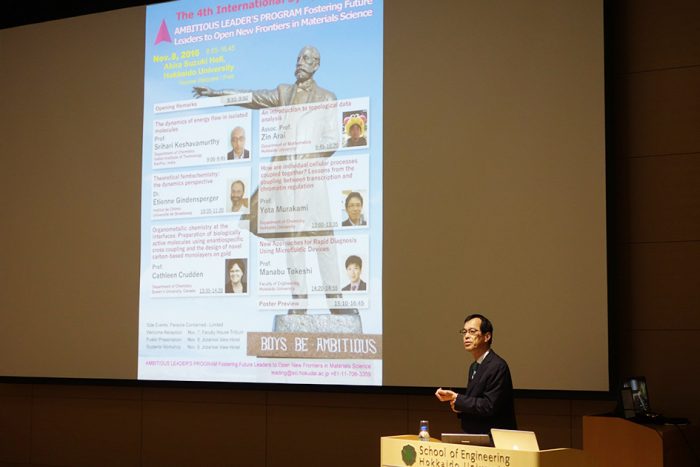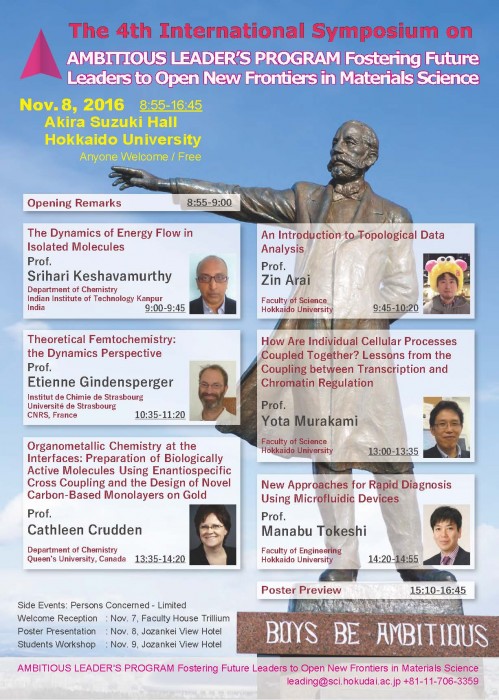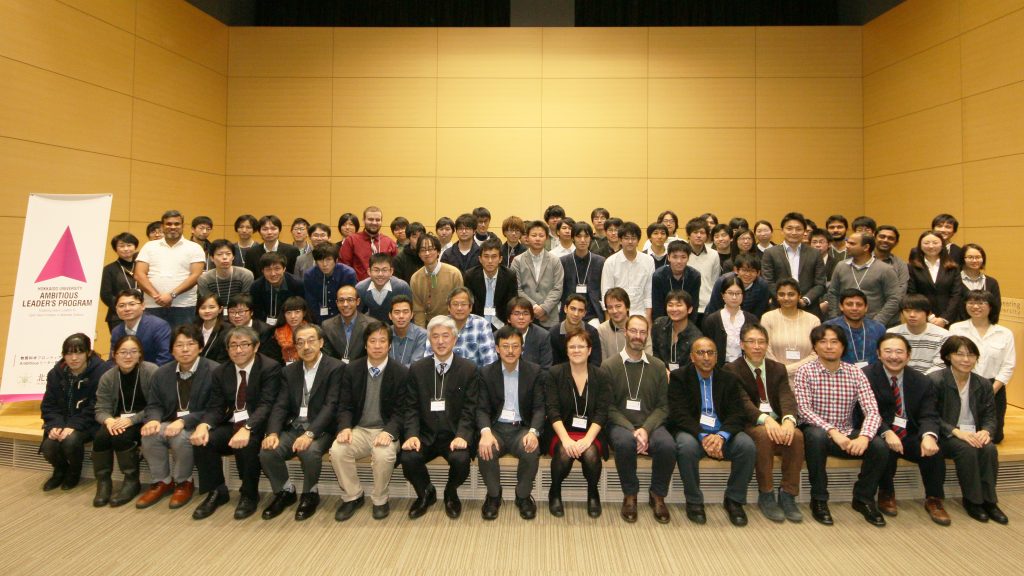
“The 4th International Symposium on AMBITIOUS LEADER’S PROGRAM Fostering Future Leaders to Open New Frontiers in Materials Science” was held on November 8 and 9, 2016. It was designed such that the program students develop globalized practical skills. In addition to seminars and poster sessions, we ran workshops that emphasized exchanging notes and making conversation with attendees invited from overseas. It is of special note that these workshops were mainly planned and operated by second-term program students.
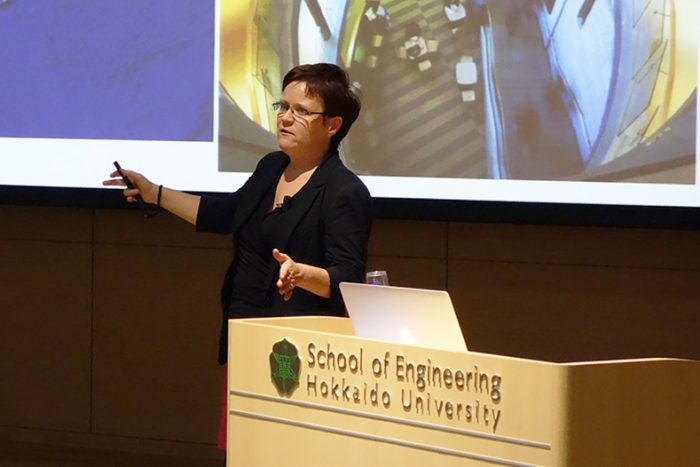
Upper Photo: Program Coordinator Koichiro Ishimori gives opening remarks.
Lower Photo: Professor Cathleen Crudden giving a lecture
Amid snowfall that was a little earlier than usual, Program Coordinator Koichiro Ishimori began the International Symposium with opening remarks. Following this, Professor Srihari Keshavamurthy (Indian Institute of Technology Kanpur, India), Associate Professor Zin Arai (Hokkaido University), Professor Etienne Gindensperger (Université de Strasbourg, France), Professor Yota Murakami (Hokkaido University), Professor Cathleen Crudden (Queen’s University, Canada), and Professor Manabu Tokeshi (Hokkaido University) lectured on the world’s cutting-edge research. The lecturers’ fields of specialization were an eclectic array, from chemistry to mathematics and from biology to engineering, and more. However, the program students also asked many enthusiastic questions regarding content that surpassed their own specialties. Furthermore, lecturers spoke on what should be learned in order to be active globally. This greatly inspired the program students. In the latter half of the symposium, students who had been waiting for the evening poster presentation reviewed their posters, and each introduced their research content. Many students did a magnificent job even if it was their first presentation in English, and it was a good opportunity to demonstrate language learning outcomes as one part of the curriculum.
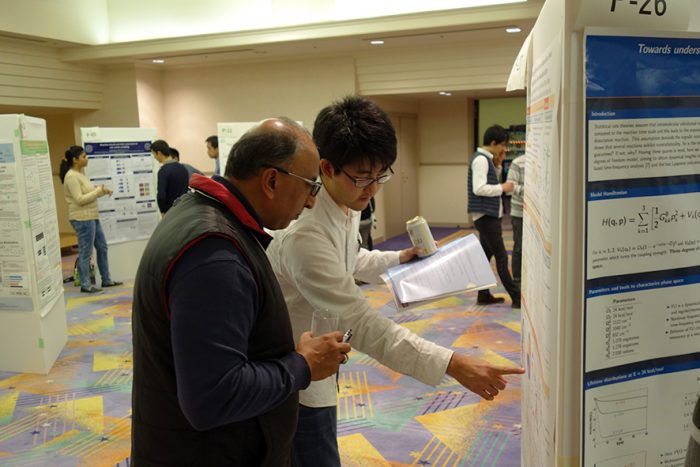
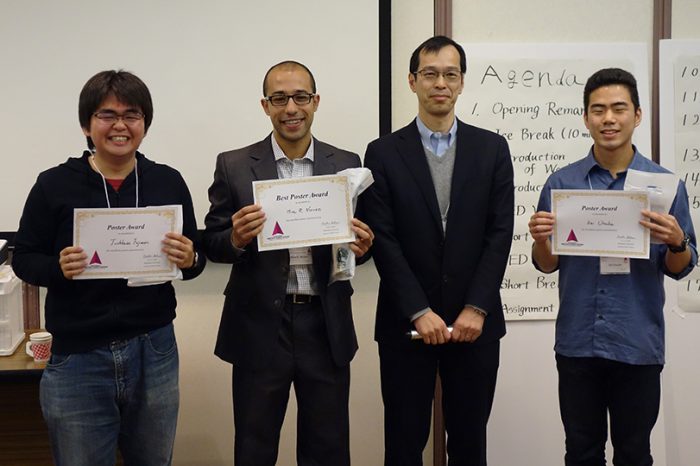
Upper Photo: Poster session on the evening of the first day
Lower Photo: Mr. Toshikazu Fujimori, who won the poster award (left), Mr. Mina R. Narouz (center), and Mr. Kai Otsuka (right)
In the evening, the event moved to Jozankei Hot Springs in the suburbs of Sapporo, and graduate students who participated in the symposium made poster presentations. Energetic discussions continued late into the evening, deepening the exchange among students who participated in the symposium and their understanding of the research content. Poster awards were decided by participants’ votes. The grand prize was awarded to Mr. Mina R. Narouz (Queen’s University, Canada), and Mr. Toshikazu Fujimori (Graduate School of Chemical Sciences and Engineering, ALP) and Mr. Kai Otsuka (Graduate School of Life Science, ALP) were presented awards of excellence.
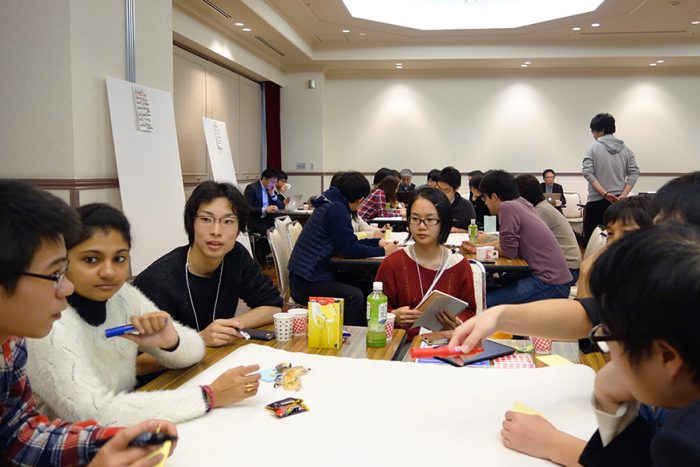
Photo: A workshop on the second day
On the second day, we held workshops planned by the program students. Graduate students from overseas and Hokkaido University graduate students joined to create mixed groups that had substantial discussions in English. After listening to Professor Jim Al-Khalili’s (University of Surrey) presentation “How quantum biology might explain life’s biggest questions,” which is the subject of his TED Talks, and earth scientist Dr. Andrés Ruzo’s (who resides in Dallas) “The boiling river of the Amazon,” participants discussed the theme of “The best method for improving interdisciplinary studies: To design the novel symposium promoting interdisciplinary collaboration.” Energetic discussions unfolded in all of the groups, and at the end of the workshops, each group presented their opinions about fusion-style research. The group presentation titled “Imagine 2030” was voted best presentation and given an award.
For the program students who participated in this symposium, the benefits were not limited to deepening their expertise. Through planning and managing the International Symposium, these students accumulated valuable experience for acquiring the sophistication to look the part as global leaders.
==
●I Was Able to Put What I Learned in the Facilitation Course into Practice at the International Symposium●
Report: Sou Yamagata, 3rd-term Leading Program Student
“The 4th International Symposium on AMBITIOUS LEADER’S PROGRAM Fostering Future Leaders to Open New Frontiers in Materials Science,” an official event of the Leading Program, was held over three days. On the day before the symposium formally began, many symposium participants joined a buffet-style party in the trillium garden next to the central cafeteria as a reception to the event. Symbols indicating participants’ hotel rooms were written on participants’ name tags (in addition to names, affiliations, and majors). This enabled participants to use name tags as conversation starters. Since the reception welcomed those from overseas, naturally, we used only English, and we were requested to take part enthusiastically in exchanging notes with overseas researchers and students. The opportunity of having a conversation with a student from India turned out to be the opportunity to work together from the next day onward. Thus, I believe that I was able to participate smoothly in the symposium.
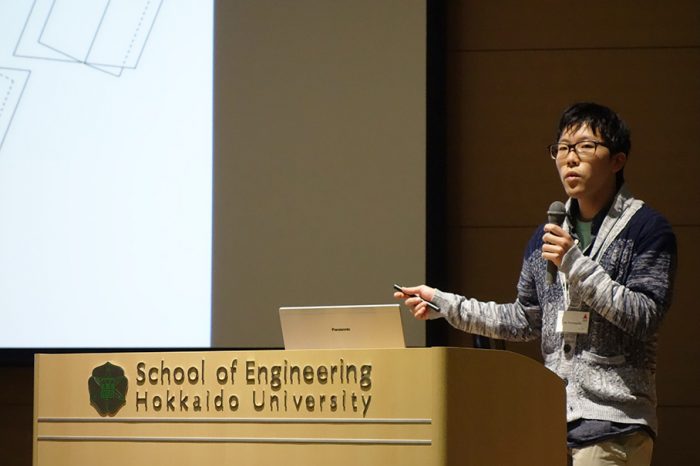
Photo: Poster review in Akira Suzuki Hall in the Frontier Research in Applied Sciences Bldg.
On the symposium’s first day, lectures and a poster review were held both in the morning and afternoon. At the poster review after the lectures, each person made a 2-minute presentation. Time was short; however, I was mentally prepared to present while keeping in mind the facilitation course I had taken previously.
After the poster review, we moved to the Jozankei View Hotel by bus, and after dinner, we had a poster session. Reflecting on my poster presentation, I decided that I was overly involved with the content of the research and, unfortunately, wrote purely mathematical content on the poster. In hindsight, I felt that I had made a somewhat self-centered poster and that, in the future, I should write content that will be of interest to people from other fields as well as being easily comprehensible.
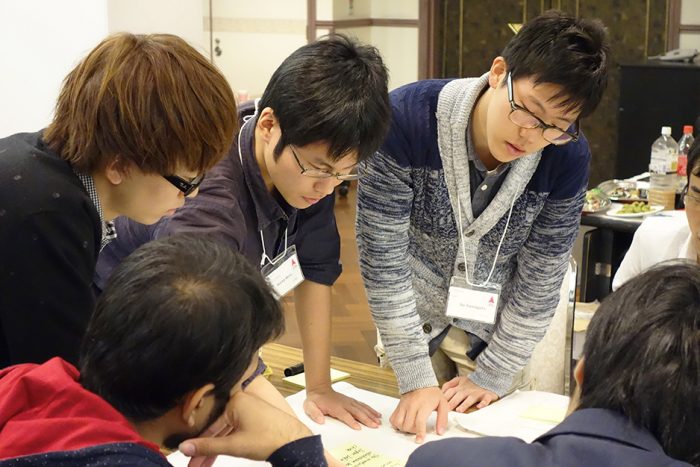
Photo: Group discussions in English in second-day workshops
On the second day, mainly workshops took place. We split into a few groups, and workshops progressed under the guidance of each group’s facilitator. I thought that this was the perfect chance to practice content from my previous facilitation course. I prepared myself to articulate what I had learned; however, it did not go as well as I had hoped because of linguistic problems, among other things. Despite this, I learned a lot of things, and for me, it was an extremely substantial workshop.
I was able to experience many things at the International Symposium, which was held over three days in addition to the day on which the reception was held, such as an international exchange that brought together students and researchers from overseas, poster sessions, and workshops. I had never had to speak English before; however, in the end, English is a tool. I think that what we talk about and how we attempt to communicate are important. In particular, when I was in the company of overseas students at our accommodations, different types of conversations arose, such as the one that occurred at the dinner table—regarding the Japanese itadakimasu greeting that we say before eating, how to use chopsticks and kimonos, and the habit of removing shoes indoors. Conversely, I was also frustrated at not quite being able to convey what I wanted to say; therefore, I believe that I must study English even more in the future.
Report: Kenji Hirai (Program Faculty)

